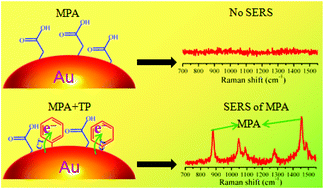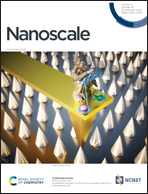Molecular hot spots in surface-enhanced Raman scattering†
Abstract
The chemical and electromagnetic (EM) enhancements both contribute to surface-enhanced Raman scattering (SERS). It is well-known that the EM enhancement is induced by the intense local field of surface plasmon resonance (SPR). This report shows that the polarizability of the molecules adsorbed on the metal surface can lead to another channel for the EM field enhancement. When aromatic molecules are covalently bonded to the Au surface, they strongly interact with the plasmon, leading to a modification of the absorption spectrum and a strong SERS signal. The effect is seen in both 3 nm-Au nanoparticles with a weak SPR and 15 nm-Au nanoparticles with a strong SPR, suggesting that the coupling is through both EM field and chemical means. Linear-chain molecules on the 3 nm-Au nanoparticles do not have a SERS signal. However, when the aromatic and linear molecules are co-adsorbed, the strong SPR/molecular polarizability interaction spatially extends the local EM field, leading to a strong SERS signal from the linear-chain molecules. The results show that aromatic molecules immobilized on Au can create “hot spots” just like plasmonic nanostructures.

- This article is part of the themed collection: 2020 Nanoscale HOT Article Collection


 Please wait while we load your content...
Please wait while we load your content...